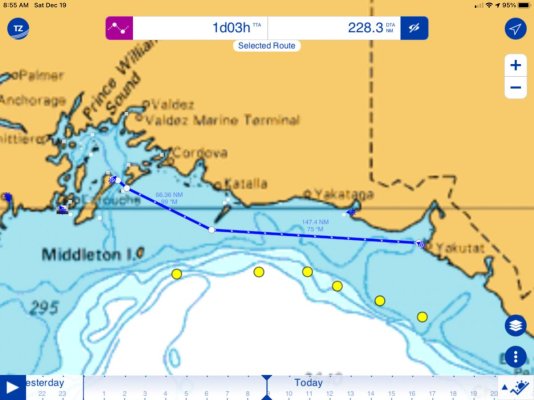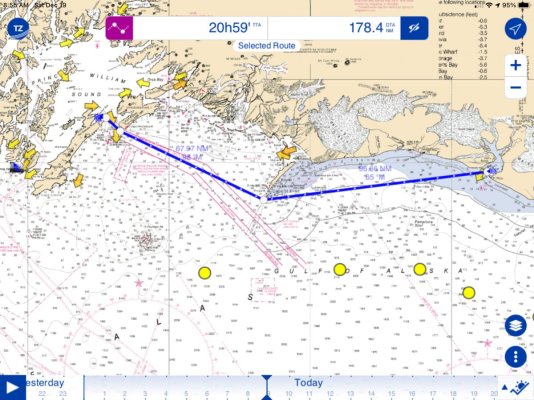After an all too short tour of Prince William Sound on a cruise ship in 2007, I have dreamed of taking a longer time touring the area in our own boat: (Nordic Tug 37)
We’ve been to SE Alaska & hope to return with more time in hand but Prince William Sound beckons.
My biggest concern in considering a trip there has been the open water crossing from Cape Spencer to Prince William Sound.
Our longest non-stop crossing to date has been Shearwater to Rose Harbour on South Moresby ~ 125 Nm. With full fuel tanks, we have a range ~ 900 Nm at 7.5 Kts so even with some adverse current etc we should have adequate reserves. Pushing the stick a bit would allow 8.5 - 9 Kts with less reserve but might reduce the time of exposure.
Which strategy is better?
This thread has helped put the prospect of that crossing into perspective. It sounds do-able with a good weather window and lots of time in hand so as to not feel pressured to go by any particular deadline.
How difficult is it to find decent anchorages in PW Sound? We have 115m (~ 375 ft) of chain so can tolerate some deeper anchorages but I’m guessing that these fjords could be quite challenging.
Mindset, If your going to make the jump, you need perspective. You have to ready your self, you boat and crew for a passage. It's way different then cruising. The best cruising you could ever image is in your future, after a successful passage. But for now, your coming up coming passage is all you'll have to think about.
All the cruising, lazy afternoons, BBQ's are over for now. It's game time, you check and re-check your boat and list. Have any crew that is timid flyout to meet you at your destination. Seasickness not a reason to scrub a mission. Unless they become dehydrated, then it gets serious, if they tend that way, don't bring them along. A helicopter rescue is not fun. Do all you can to prepare, focus only on the goal. Ditch your cruiser friends, they have a different mindset.
If the weather is unfavorable, get away from the frigging dock, find a spot close to your exit and anchor... alone and keep watching. Work you plan... No reason to be anxious, your snug and you have a plan, your ready, just wait for the window then haul ass! You're in control of your actions. No one to egg you on or hold you back. I hate traveling with another boat. No two boats travel the same, they will leave you or hold you back. It's your gig, work it. Do not look back at land when you stick your nose out and start bucking around. Currents pouring in and out of inlets can make some lousy conditions the first few hours. Believe it or not only look ahead, you're done with the place behind you for a while, say thanks and get rolling. You have to look for your next landfall, looking back beckons you to turn around.
Get the boat humming, eliminate any noise like clinking or stuff rolling around. No clunking clinking noises from crap rolling around. Is a great feeling to have a boat quietly doing what it's designed to do. If my boat is quiet in 25 kts. of wind, it should be quiet in 70, or I will hear anything new. If something is rolling around, and the water turns bad, that annoyance can become dangerous if you try to chase it down. Turn up the music, don't wear earbuds, put the crew to bed, have them watch movies or get something to eat, staring into a big gray nothing can make you all anxious.
If you tend towards seasickness, do not eat drugs or stupid bands or anything from West Marine.. Eat apples, only. No coffee, bacon, nothing. Puking tastes just like warm applesauce...then have another apple...I kid you not, it's not bad...

Everything is good, your on track, you got this, but it's a mind game, just keep it going, you're in a waiting game. Boring as hell sometimes, but you got a goal, and you're eating up the miles. Watch changes may only time you see anyone else. It's OK you're not cruising for pleasure, you have a passage to make. Getting it done is not exciting or glamorous, it may have a few miserable hours. But your mindset will determine the success and build your confidence to make further trips.
Using new or newly honed skills will increase your boating pleasure. One of the best sailors I ever knew said
"Jack, never fear going to sea, land is the danger to your boat.










